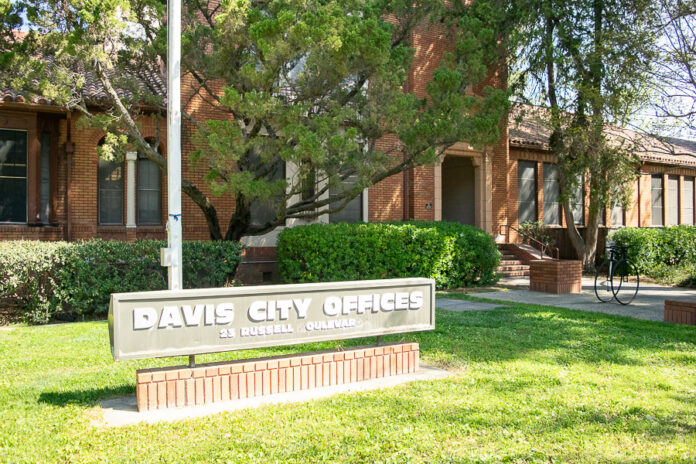City to promote sustainable landscaping with City Hall frontage redesign
Landscape irrigation accounts for up to 65% of water use in the Sacramento Valley, according to the City of Davis website. The site goes on to encourage residents to implement sustainable landscaping that will reduce water use and runoff, improve wildlife habitat and foster healthy soils. With the Russell Boulevard Green Street Demonstration Project, the city aims to go beyond only encouraging sustainable practices by demonstrating these practices in action.
The Russell Boulevard Green Demonstration Project — which the city must complete no later than May 1, 2020 — will redesign the Russell Boulevard frontage of City Hall, converting nearly 25,000 square feet of turf to drought tolerant landscaping. The grant-funded project will also create seven new gardens and planters, new permeable paved seating areas and walkways and a vegetated swale — all of which is intended to capture, filter and control stormwater and runoff.
Candidate plants for the project include native and adaptive drought tolerant plants such as “island pink,” baccharis pilularis and “blonde ambition,” as well as stormwater plants like “elk blue” and accent and street trees.
Mayor Brett Lee commented on these plant type changes.
“We’re expecting that it’ll actually be a good example of sort of native plants and things that typically use less water,” Lee said.
Showcasing these sustainable techniques specifically at City Hall is a strategic move. Mike Webb, the city manager, said that the city hopes to lead by example in offering these examples of green redesign.
“The idea of doing it at City Hall really arose out of the idea that we have a lot of people that visit us and visit City Hall that are local architects [and] contractors that could benefit from seeing first-hand some of these techniques put into practice,” Webb said. “We as a city often find ourselves in a position of requesting — or in some cases even requiring — that certain drought tolerant features and runoff control features be integrated into private development projects. What better way to help sort of encapsulate that or to sort of promulgate those ideas by us as the city doing as we say?”
Stephen Wheeler, a landscape architecture and environmental design professor at UC Davis, said that the project seemed like a good idea, and highlighted the importance of sustainable practices like stormwater control.
“There’s no reason why not all stormwater runoff should be handled onsite by streets and parking lots,” Wheeler said. “That’s better for the ecology of the water table, and it avoids runoff into local waterways, which tends to erode and to have negative effects, and just takes the water out to the Pacific Ocean.”
The project is funded by a California Natural Resources Agency Urban Rivers grant, which was awarded to Davis in December 2017.
The 2014 Proposition 1 Water Bond funds the Urban Rivers grant program in order to support green infrastructure projects that “conserve water; improve water quality; buffer climate change impacts; reduce greenhouse gas emissions; and restore as well as protect rivers, creeks and streams,” according to the city’s calendar event of a Russell Boulevard Green Demonstration Project community input session.
In addition to its greening efforts, the project may also make City Hall more inviting to visitors, incorporating two plazas with permeable paving, shaded seating and interpretive signs, as well as new sand pedestrian pathways and an ADA-accessible boardwalk.
Dale Sumersille, the parks and community services director and lead on the project, said signage will be educational, referencing hopes for QR codes on the signs.
“Our goal is also with this project is to make this an opportunity for education,” Sumersille said.
Sumersille acknowledged the limits of Davis’ current green infrastructure teaching.
“[What] we need to do a better job of is in educating the public of what green infrastructure looks like,” Sumersille said. “Sometimes they’re very overwhelmed by some of the things, so if we can show them this is what we mean, then they have a better understanding of it.”
The project as a whole also features a public art opportunity. The civic arts commission is seeking an artist or collaborative team to design artwork that will adorn the faces of six planned concrete seat cubes, each measuring 2 feet by 2 feet. The city’s request for proposals said the artwork should “reflect sustainability, greening-related themes, local flora and fauna, history of place, and/or the architectural themes of City Hall,” and suggested using mosaic glass, tile or stone panels, ceramic tile squares or “artfully arranged items encased in weather-resistant resin.”
The artwork element is planned to be unveiled in November of 2019.
Currently, the city is still in the bidding process. Sumersille said that the city had to go out to bid a second time, as bids received for construction the first time around were incomplete.
Cunningham Engineering has been developing the project design, and Sacramento Regional Conservation Corps will help with the demo.
The city has sought to involve the public both with community outreach meetings for the project and with a volunteer opportunity that will be announced toward the project’s completion in which community members can help with landscaping.
Wheeler said that this project leaves opportunity for more implementation of green streets and sustainable landscaping practices.
“The biggest story might be simply that maybe we’re entering a new era of street and parking area design in Davis that many of whose strategies will be illustrated by this,” Wheeler said. “Green streets are a movement which is relatively recent, which hopefully will expand quite a lot.”
Written by: Anne Fey — city@theaggie.org




